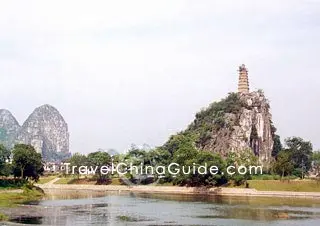Chuanshan Park
The Li River offers plenty of beautiful sceneries, such as the graceful idyllic Chuanshan Park on its east bank, with the clear Xiaodongjiang River passing by. Chuanshan park is famous for its Cockfighting Hills, formed by the Chuanshan Hill and Pheasant Hill. The two hills together resembles 2 cockerels itching for a fight. Other significant spots worth taking in are the Pagoda Hill on the west bank of Xiaodongjiang River, the Chuanshan Hill Cave, a large karst cave, and the Moon Cave.
Cockfighting Hills
It was said that a long time ago, a group of intellectuals went to Guilin to take imperial examinations. While passing by the Cockfighting Hills, one of them composed 'Dou ji shan shang shan ji dou' (Two cocks are fighting on Cockfighting Hills) as the first line on a couplet. The rest racked their brains trying to come out with a second line in response to the first but no one succeeded. Years later, two of them went back to Guilin again. When they dropped by a place called Dragon Hiding Cave (Long Yin Yan), the name inspired one of them to come up with the second line - 'Long yin yan zhong yan yin long' (A dragon is hiding in Dragon Hiding Cave). The long awaited puzzle was then solved.
Chuanshan Hill (Tunnel Hill)
Chuanshan Hill Cave
Moon Cave
Pagoda Hill
 |
| Pagoda Hill |
Pagoda Hill inside Chuanshan Park belonged to the same mountain range as the Chuanshan Hill a million years ago. The movement of the earth's crust divided them into two hills on the opposite bank of Xiaodongjiang River.
Pagoda Hill got its name because of the hexagonal Longevity Buddha Pagoda on it. Built in the Ming Dynasty (1368-1644), the seven-storey brick tower has a multi-eave pagoda with a height of 13.3 meters (44 feet). A statue of the Longevity Buddha (Amidabha Buddha) was carved on the north wall of the tower.
Pagoda Hill is also called Warship Hill because of the similar shape. Many maple trees are planted at the foot of the hill. Fiery-red maple leaves give visitors another stunning view in late autumn.
How to get to Chuanshan Park
Guilin Bus Search
| Entrance Fee | Free |
|---|---|
| Opening Hours | 9:00 – 16:30 |